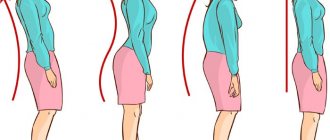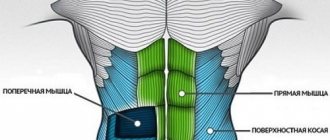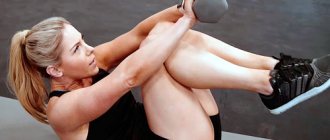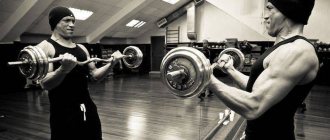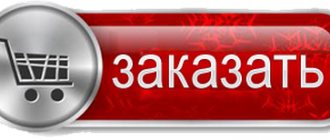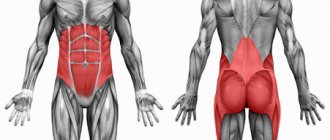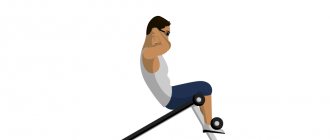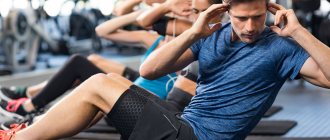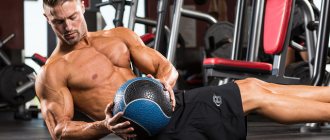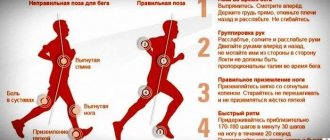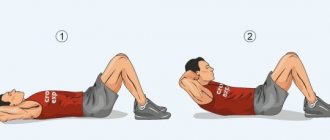Lightweight abdominal exercises if there are no back injuries
If your back hurts, but diagnostics have not revealed any serious problems or diseases, your option is to do your usual abdominal exercises with a smaller amplitude. For example, a typical exercise (with raising the body from a lying position) should be performed without lifting the lower back from the floor. That is, do the usual number of repetitions, but only lift your shoulder blades off the floor. If you do not strain your neck muscles during exercise, the risk to your back is minimal. The same applies to exercises with raising your legs from a position on your back - do not raise your legs high, indicate the movement and that’s it, at the same time, do not lift your lower back from the horizontal surface. [box#2
Special cases
Is it possible to work out your abs in the gym when you have a big belly?
This is a separate topic, filled with thousands of nuances. A large belly will cause you pain even while lifting your torso while lying on the floor. What can we say about the Roman chair?
A good option for you is exercise on a fitball. If your back hurts, it is best to train with support. Until your muscles are ready to work independently, the ball will be a very necessary item for your training.
First of all, you need to remove belly fat. At the same time, we can only strengthen his muscles, rather than pump up anything. And you will need to start with small amplitudes. Each time we try to make the range of movement larger.
For example, when lifting the body while lying on the floor, we will first try to raise the head, then the neck, and chest. One day, with a full repetition, you will notice that nothing hurts. And then you can do the whole approach without pain.
Remember that your belly kills your spine. Why not lose weight!
And one more important principle of training: “I train muscles for myself, because I like it, it’s useful.” It doesn’t matter, at home, in the gym – the work is going on, the muscles are being trained. Then you won't harm yourself.
What to do if your back hurts
If you have problems with the spine, nerves, cold muscles, changes in your figure after childbirth, Pilates is your option. This program was developed for the rehabilitation of military personnel after injuries; it consists of almost static poses. It is almost impossible to tear your back or injure it while doing Pilates. Pilates has a huge number of static abdominal exercises that are considered extremely effective.
If you do Pilates two to three times a week for an hour, results will appear within a month. Moreover, you will not only strengthen your abdominal muscles, but most likely improve the condition of your back, legs and arms.
Join a good Pilates studio and they will explain the principles of the exercises to you. Try different types of exercises - with a bodyball (a ball with a diameter of fifty to sixty centimeters) or a special tape. As a rule, in large fitness clubs there are entire classes dedicated to working on the abs.
If you are uncomfortable working out in the gym with other people, you can order two or three personal lessons to understand how to move correctly, what to pay attention to when doing exercises, and get personal recommendations. After which you can buy a disc with a set of exercises, a bodyball and practice at home.
If you have a lot of weight and a sore back, in order not to injure it even more, sign up for water aerobics. Water will support you, take the stress off your spine and knees, and abdominal exercises within this load are enough to achieve good results for several months.
Welcome to the third lesson of my lumbar spine rehabilitation course. Today we will talk about why it is very important to pump up your abs for lower back pain and lumbar osteochondrosis.
If you haven't watched the last lesson of the course, be sure to watch it here first >>
So, in the last lesson, we discussed in detail why it is important for the lumbar spine to strengthen the muscle corset and restore connection and coordination between the individual muscle groups of this corset.
We also analyzed a detailed scheme for lower back restoration from the very beginning (from the subacute period), when the simplest exercises need to be performed and only in a lying position, to the full inclusion of the entire arsenal of different exercises for normal balance and health of the lumbar spine.
I hope you remember from the last lesson that you need to start doing therapeutic exercises with the simplest exercises that involve only one group of corset muscles.
And as part of the muscle corset we have four muscle groups:
- Back muscles
- Muscles of the anterior abdominal wall
- Obliques
- Quadratus lumborum muscle
Many people make the mistake of immediately starting exercises for the back muscles. After all, it seems that this will help quickly remove residual effects and strengthen the spine.
In fact, this is wrong. The back muscles (and quadratus lumborum) should be included in therapeutic exercises ONLY AFTER strengthening the muscles of the anterior abdominal wall.
How to train your abs for lower back pain
If you have a pinched nerve or a cold, the pain will intensify when you press your abs. There are often cases when there is nothing like this, and abdominal training still causes pain.
The reason for this is simple: your muscles are too weak to provide a safe position for your body during the exercise. You need to train in a special way before the pain goes away.
In what cases can your back hurt when doing exercises on the abdominal muscles?
Roman chair and incline bench exercises often cause back pain the first time. Why is that?
This is because the muscles are not strong enough to support your body in a horizontal position without support. The spine begins to warp, and the vertebrae move relative to each other. This leads to minor irritation of the spinal roots, which you feel as pain.
If you have been practicing for a long time and are trying a new abdominal exercise, pain may also appear with this option: raising your legs while lying on a bench and then lifting your pelvis off it. At the same time, your legs go up. At the moment of separation, you can feel a sharp pain.
Excess weight is the enemy of the spine
If any of you were in the neurology department and saw patients with radiculitis, he knows one secret. Almost all patients with radiculitis are overweight people. At least they have a big belly.
We already walk on two legs, the load on the spine is already greater given its limited resource. And then there is the stomach, which forces the lower back to bend more than necessary in order to maintain balance when walking. In this case, we can’t even talk about any abdominal press. Therefore, task number one is to remove the belly. Believe me, this is the most difficult thing. Because the starting point is a very neglected state. Then you’re just too lazy to do anything, and your physical fitness is so sluggish that every workout will look like a torture chamber.
And, remember, the greater the weight and your belly, the worse it will be for your spine. Ask any mother what it’s like to have, even temporarily, a big belly.
Is it safe to exercise when your back hurts?
It all depends on the nature and type of your pain, the condition as a whole. If you once felt pain while doing abdominal exercises, you need to figure it out. Before you go to the doctor, let's do an experiment:
- Place a fitness mat on the floor of your home. Ensure there are no drafts.
- Lie on your back. Place your hands behind your head, legs together. Raise your right straight leg as high as possible. Pull it as far as your ligaments allow.
- Listen to yourself - is there pain? If yes, contact a neurologist.
- If not, do the same with the other leg. Doesn't it hurt again? Great, then work your muscles this way for a couple of weeks before the Roman chair.
- We lie down on the mat on our back again. Hands behind head.
- We bend our legs at the knees.
- Lift your body up, starting from your head. If at some point you feel pain, we recommend performing the exercise until that painful moment. Gradually the pain will go away and you can move on to the Roman chair. In fact, you are preparing your abs to increase the load with classic crunches.
If it hurts you to bend or walk, and the pain radiates to your leg, buttock, right or left pelvis, it’s time to see a doctor. Sometimes it happens that you bend over, and the doctor will straighten you up.
The "magic" scheme for overcoming pain in the gym
If you came to the gym for the first time and started working out your abs on a Roman chair, pain is normal. No need to worry, your muscles are just not ready. It’s another matter if you’ve already had back pain before and you’ve been diagnosed with some kind of sore. And even in the latter case, don’t give up - you will succeed!
Lesson scheme for beginners:
- Let's forget about the Roman chair for now. We will pump up our abs on the floor with our feet on the bench. To do this, you need to move the bench so that if you raise your hips perpendicular to the floor, it will be exactly under your knees. Hands behind your head is the starting position. We do 2-3 sets of 15 times. We alternate straight lifts with oblique ones (that is, the right elbow reaches towards the left knee and vice versa).
- Raise your legs while lying on the floor. Alternatively, you can do leg raises. To do this, you need to rest your elbows on the armrests attached to a wall bars or a special abdominal exercise machine. Legs slightly bent at the knees - lift them 2-3 sets of 10-12 times (according to how you feel).
- Don’t forget to pump up the antagonist muscles as well. Exercise “boat”, or hyperextension without weights. If it hurts, keep your posture!
After 2-3 weeks of such training (we do 2-3 times a week), your abs will be ready for the Roman chair and incline bench. You will be able to do weight-bearing exercises.
If you have had an injury, you should consult with your sports physician about what you can and cannot do. It is the sports doctor who should advise you something, because classical medicine in this case will not offer you anything. Except, of course, “tread carefully.” And how “careful” this is - guess for yourself.
There are many diagnoses. You need to know what exactly happened to you. Read on to find out what we recommend doing in each specific case. In the meantime, you can train your abs at home by alternately lifting your legs and body several times a week.
If you have acute pain, you should absolutely not exercise until you relieve the inflammation. Even on the floor.
Weight and back pain
Many beginners, feeling that it is easy for them to pump up their abs on a Roman chair, take up plates. They take 15 kg and begin to twitch, pumping their abdominal muscles. What is going on in their head at this moment is the mystery of the century. But it is very clear how the lower back suffers. She is deformed.
The muscles cannot yet support the body without weight, and the person grabs the weight. The vertebrae are distorted, the discs are worn out. The back is gradually injured. Moreover, this injury will not manifest itself immediately, but as soon as a person has a deficiency of joint-forming substances in the diet.
We do not recommend immediately training on a Roman chair with weights for beginners and those who have previously had back pain. Strengthen your muscles, exercise for 2-3 months before you pick up a weight plate or dumbbell. And if you take a weight, it’s better to press it to your chest.
Dangerous abdominal exercises that cause pain
There is such an exercise for pumping the lateral abdominal muscles. It is made in a block frame on the lower block. They stand sideways to the lower block and pull the weight towards themselves with the force of the lateral muscles. At this moment, a very undesirable load on the lower back occurs - from top to bottom and slightly to the side. With a sore back, one such approach with weight is enough to activate inflammation.
Exercise therapy for the press: diagram of load construction
As you understand, in the subacute period we perform the simplest and easiest exercises, lying on our backs and with a flat pillow under our lower back.
Look at video examples of such exercises.
https://youtu.be/Vh7wAN2VoTI
Do you think that in this case the press does not work?
It is due to his work that such therapeutic exercises are performed!
This is how we put the abs into work first - from the simplest exercises. An important condition is that for now we include such exercises only in the main part of the complex, alternating with other unloading exercises.
Usually 4-5 days are enough to move on to other therapeutic abdominal exercises. At this stage, we continue to do exercises in unloading positions, but not only lying on our backs, but also lying on our stomachs, standing on all fours.
How to properly complicate the load on the abs without overdoing it?
An example of abdominal exercises with increasing load: lifting both legs, bent at the knees and hip joints, first without the participation of the pelvis. Later we make it more difficult - we begin to raise the bent legs together with the pelvis.
At the same time, we engage the back muscles in the work, performing therapeutic exercises while lying on the stomach.
Here is an example of a mini-complex for the abs and back muscles at this stage.
https://youtu.be/izNW7uppZqw
Of course, do not forget about the warm-up and cool-down in order to properly prepare the body for work and properly relax it after completing the main complex.
Later you need to diversify the exercises, combine exercises for different corset muscle groups, using different starting positions. This way you will gradually strengthen all the core muscles.
Then the abs and strong back muscles will take on household loads and evenly distribute them among themselves, unloading the spine and keeping it healthy.
Such a scheme will be safe and at the same time effective.
All sets of exercises in the program are divided into four stages:
- The first stage - subacute period - all exercises only strictly lying on your back in combination with relaxation and breathing exercises
- The second stage – strengthening the anterior abdominal wall and “helpers” of the lumbar region – exercises for the transition period and preparation for the third stage
- The third stage is strengthening the muscle corset - exercises to work out all muscle groups of the corset. They are distributed so as not to create a large load on the lower back, but also gradually strengthen and restore it
- The fourth stage is stabilization of the spine - exercises in a standing position, bending over, balance exercises in combination with unloading exercises. Once you have strengthened and restored the balance between the large muscle groups, you can work on the small muscles that stabilize the spine.
Why should the abs be included first in physical therapy?
The fact is that the muscles of the anterior abdominal wall (hereinafter I will call them “abs”) are direct antagonists to the back muscles. That is, they perform the opposite role than the back muscles. The press bends the spine, and the back muscles straighten it.
These muscles must work in pairs ideally in order to keep the spine in the correct position and prevent distortions due to impaired tone.
But from the very beginning of recovery, we cannot yet work with the back muscles due to the fact that the exercises must be performed at least while lying on the stomach and putting in enough effort to do this. But we can calmly work on the abs in a supine position.
When the exacerbation passes, the subacute period begins. Some pain may persist, there may be muscle spasms, and you may find it difficult to stand on your feet all day.
During this period, we still perform the simplest exercises - unloading, light, strictly lying on your back, placing a flat pillow or folded towel under the lumbar region.
At this stage, the main goal is to finally remove pain, relieve inflammation, improve blood circulation and prepare the body for the next stage of stress.
It is during this period that we include therapeutic exercises to strengthen the abs.
If you now doubt this, and you associate abdominal exercises with athletic exercises, with all sorts of twisting and heavy hard work, then you are mistaken.
Let's start with the most important things
We won’t bore you and in a telegraphic style, we will briefly, or almost briefly, describe the most necessary facts that you should know before you start pumping your abs:
There is a popular expression in the fitness community: abs are made in the kitchen, not in the gym. This means that you need to improve your diet and consume fewer calories from food than you expend.
Local fat burning does not exist, so for the purpose of losing weight specifically in the abdominal area, abdominal exercises become useless. They are needed functionally to develop muscles, but not for weight loss.
When we have understood the most important points regarding the abs, it’s time to move on to harmful and dangerous exercises!
Harmful exercises
An example of a harmful abdominal exercise is straight leg lifting with a fixed body. Moreover, whether you raise straight legs from a lying position, or do it from a vertical position with emphasis on the lower back, this harms your spine.
Studies have shown that straight leg raises cause significant compressive stress on the intervertebral discs of the lumbar spine. In this case, the maximum force occurs at the moment the heel lifts off the surface of the plane.
In general, it is the rectus muscle, which we call the abs, that works in this exercise when the pelvis is twisted. Until this moment, the iliopsoas bears the main load.
Contraction of the iliopsoas muscle creates increased pressure on the vertebrae in the lumbar spine, and this can gradually create conditions for the appearance or intensification of disc herniation, protrusion, scoliosis, hypertonicity around the vertebral muscles of the lumbar spine and the muscles of the pelvic day.
Especially if such a load is carried out regularly, the accumulation of microdamages begins in healthy discs, and even more so in those previously damaged by injury or simply having degenerative changes for any reason, damage and hernias occur.
How to treat lower back pain
In the hospital
Let's tell you a little about what awaits you at the hospital if you come for an appointment.
It is best to contact specialized ultrasound centers rather than see a neurologist at your place of residence. The fact is that a government agency may simply refuse to help you, citing your young age. And this happens quite often. The doctor will look at the seemingly healthy athlete and wave his hand.
At the ultrasound center, you will undergo an ultrasound diagnosis of the lumbosacral spine and will determine exactly what is happening there. Next, the scheme is simple - anti-inflammatory drugs, vitamins and, possibly, an orthopedic belt with stiffeners. The latter will be very useful, be sure to stock up on it. But only if it is recommended to you. Sometimes it does not relieve pain in any way and will only be useful when carrying heavy loads.
In more severe cases, the situation may lead to hospitalization, for example, with acute radiculitis or a rapidly growing intervertebral hernia.
An orthopedic belt will save you at home. Wear it every time your spine hurts. Usually 1 hour a day is enough to relieve inflammation. And then you need to work on your abdominal muscles. Attention, for pain coming from the sacral region, the belt will not provide an analgesic effect, since it does not fix this part of the spine.
Even for people admitted to the neurological department with radiculitis, who cannot fully straighten up for 2-3 days, doctors recommend physical therapy. It consists of 8-10 lightweight exercises that work both the stomach and back. Got the hint? Pump up your stomach and back, and your lower back will never (or almost never) hurt.
Go to any sports ground and practice there. Raise your legs while hanging on the horizontal bar, pump your abs on the uneven bars. Walk quickly, lifting your knee high in front of you. Do what you can and don't look at those who do nothing.
Nutritional Features
Everyone says that nutrition should be balanced. What does this mean, besides the optimal ratio of BZHU? Vitamins - once! Active additives – two! The body lacks polyunsaturated fatty acids - eat unrefined sunflower oil, 1 tablespoon per day.
Our joints are experiencing a deficiency of elastic substances - we buy the drugs chondroitin and glucosamine. We eat 2 times a year for a month.
Vitamins are best for sports (we are athletes). By the way, sports vitamins are more expensive than regular pharmacy ones, not because of some cool brands, but because of the composition. Look at the concentrations of working substances in them. Therefore, it is better to drink these vitamins rather than pharmacy ones. There will be much more sense.
And don’t forget about the balance of proteins, fats and carbohydrates for normal progress in strength and muscle mass.
